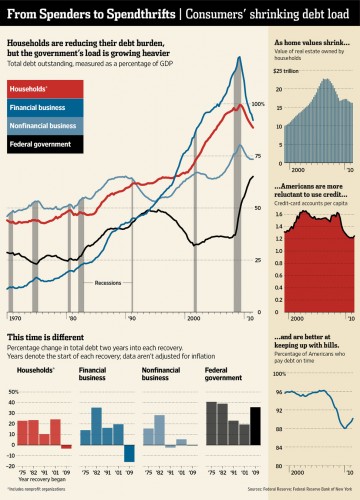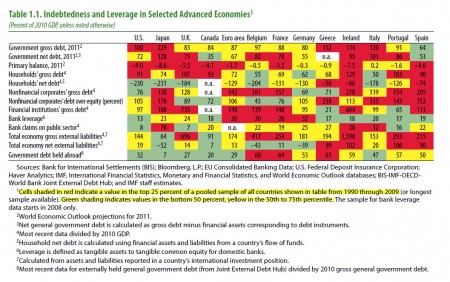Home » debt deleveraging
Category Archives: debt deleveraging
What is Corporate America waiting for?
Interview of former HP CEO Carly Fiorina. This is a nice illustration of how uncertainties hinder business investment.
With household demand severely crippled by the burst of the biggest housing bubble in US history, I don’t see how that demand could be quickly revived. Now it seems that China’s also slowing down, so the profit channel from overseas could also be in question. Oh, dear…
US 10-year Treasury Yield at 220-year Low
The 10-year Treasury yield is one of the most watched market and macro indicators. For example, former Fed Chairman Alan Greenspan watched the yield regularly. Once he sees the yield, he immediately knows what’s going on with the US economy.
Today (July 23, 2012), the yield reads 1.43%. In the last couple of months, with European situation not getting better, and the US recovery seeming to falter again (for the consecutive three years), the yield has remained at historical low level around lower 140 bps.
To put this into historical perspective, according to the research by Bank of America /Merrill Lynch, this is the lowest level since 1790, lower than the yields after the WWII, more than ten years after the Great Depression. See the chart below.
At this depressed level, it seems to indicate the US economy will remain subpar for many years to come – another Japan?
Great leap backward
How the Great Recession and European debt crisis have turned back the growth “clock” of most advanced economies, sometimes more than ten years. Looks like Ken Rogoff was right: this is not Great Recession; it’s Great Contraction.
[singlepic id=43 w=600 h=450 float=]
Source: Economist Mag.
America’s ongoing debt deleveraging
Since the financial crisis erupted, millions of Americans have ditched their credit cards, accelerated mortgage payments and cut off credit lines that during the good times were used like a bottomless piggybank. Many have resorted to a practice once thought old-fashioned—delaying purchases until they have the cash.
As a result, total household debt—through payment or default—fell by $1.1 trillion, or 8.6%, from mid-2008 through the first half of 2011, according to the Federal Reserve Bank of New York. Auto loan and credit-card balances in August had their biggest drop since April 2010, the Federal Reserve said.
“Folks aren’t borrowing,” said Jim Ernest, executive vice president at Provident Credit Union in Redwood Shores, Calif. “They are paying down debt and continuing to save.” Since January, 12% of the credit union’s mortgage customers have made at least $1,500 in extra payments.
Nearly 300 borrowers have made at least $1,000 in additional payments on car loans from Provident, said Mr. Ernest, who confessed he sometimes can’t sleep—Provident’s loan portfolio has shrunk by a quarter since the end of 2008.The change in attitude stretches far beyond Mr. Ernest’s credit-union members: two-thirds of Americans polled online in July by U.K. research firm Absolute Strategy Research said they planned to either reduce their debt within a year or stop borrowing altogether.
…
From 1997 to 2007, household debt ballooned from 66% of economic output to 98%, according to Federal Reserve data. As of June, the percentage had since been whittled down to 89%.
American households closed 103 million credit-card accounts. And credit-card payments exceeded purchases made with plastic by an estimated $116 billion between the end of the first quarter of 2009 and the end of the second quarter of 2011, according to TransUnion LLC.
…
Debt Snapshot
A snapshot of debt (government, household and corporate) of world’s advanced economies. For a hint of what’s likely to be the end of the game, read my previous post, “The moral breakdown“.
(click to enlarge; source: IMF)
Marc Faber on ways to cure the debt disease
Interview of the outspoken Marc Faber:
Mike Mayo: the US has become Japan-like
The Fed’s Operation Twist pushed 10-y US Treasurys solidly below 2%, crushing Banks’ profit margin. Mike Mayo says this will be the worst decade for the US banks since 1930s.





